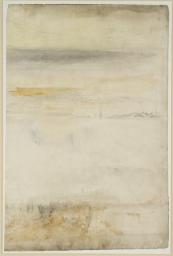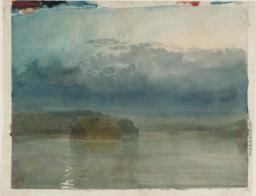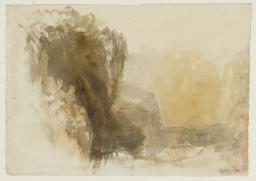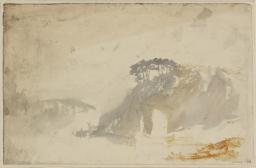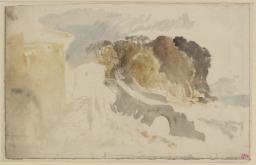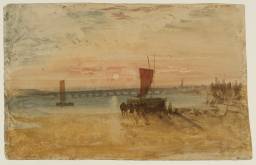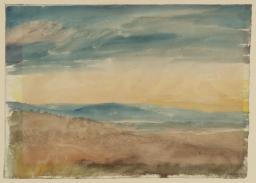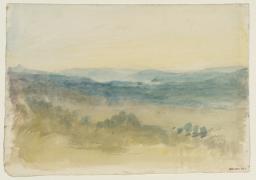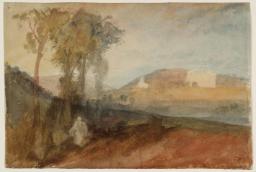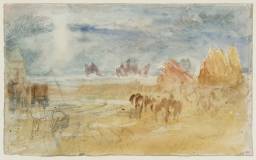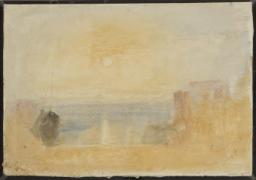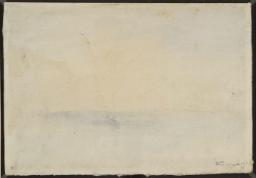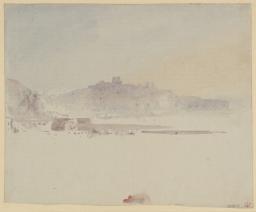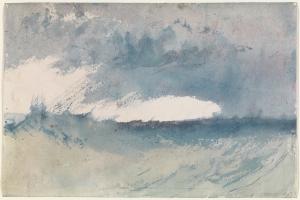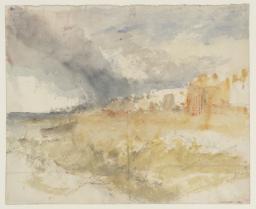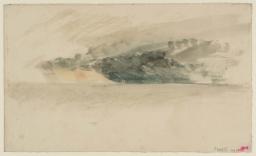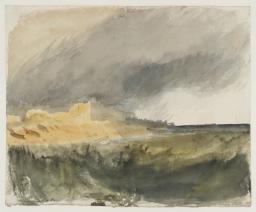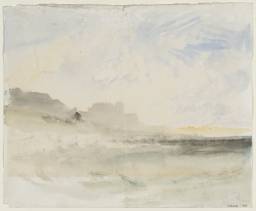Colour Studies Relating to the ‘Picturesque Views on the Southern Coast of England’, South Coast and West Country Subjects c.1811–28
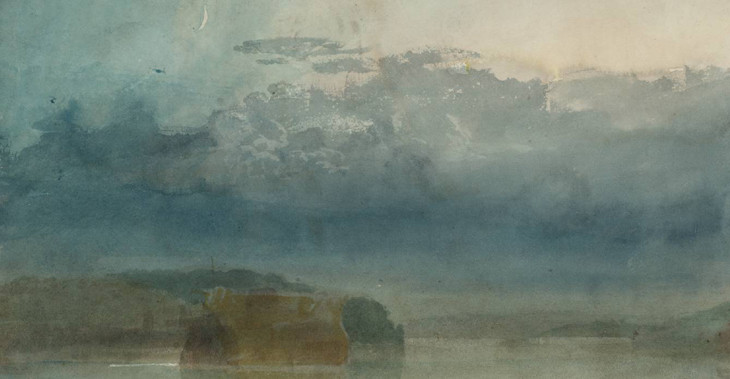
From the entry
This section comprises ‘colour beginnings’ of varying degrees of finish and a few more developed compositions, showing locations along the South Coast of England and in the West Country, including some inland subjects there; for a discussion of the function of such works in general, see the Introduction to the ‘England and Wales Colour Studies c.1825–39’ section. As set out by the present author in the Introduction to the ‘West Country 1811’ section of the catalogue, Turner first thoroughly explored the area in that year, concentration on key sites along the coast as he gathered topographical drawings for watercolours commissioned by W.B. Cooke for a proposed series of engraved Picturesque Views on the Southern Coast of England. There have been various detailed accounts of the commissioning and execution of the project by Cooke and his associates, in collaboration with publishers John Murray and the Arches, particularly in terms of Turner’s ...
This section comprises ‘colour beginnings’ of varying degrees of finish and a few more developed compositions, showing locations along the South Coast of England and in the West Country, including some inland subjects there; for a discussion of the function of such works in general, see the Introduction to the ‘England and Wales Colour Studies c.1825–39’ section.1
As set out by the present author in the Introduction to the ‘West Country 1811’ section of the catalogue, Turner first thoroughly explored the area in that year, concentration on key sites along the coast as he gathered topographical drawings for watercolours commissioned by W.B. Cooke for a proposed series of engraved Picturesque Views on the Southern Coast of England. There have been various detailed accounts of the commissioning and execution of the project by Cooke and his associates, in collaboration with publishers John Murray and the Arches, particularly in terms of Turner’s watercolours and the engravings made from them.2 Initially he was asked to provide twenty-four designs, but his contribution eventually ran to forty; none of the finished watercolours is in the Turner Bequest or the main Tate Collection. Cooke’s Ports of England scheme included some of the same locations (see Alice Rylance-Watson’s ‘Ports of England c.1822–8’ section), and may also come into play in terms of the variant compositions catalogued here.
The Southern Coast engravings were issued between 1814 and 1826 and subsequently as a book, published by John and Arthur Arch and others as Picturesque Views on the Southern Coast of England, from Drawings Made Principally by J.M.W. Turner, R.A. and Engraved by W.B. Cooke, George Cooke, and Other Eminent Engravers (London 1826). A copy with volumes I and II bound as one is held in the Tate Britain Prints and Drawings Room, and separately accessioned plates in the Tate Collection are noted below, where the designs to which colour studies included here can be related are listed as numbered and titled in the 1826 edition. This presented the series in a geographical sequence, clockwise from Whitstable in Kent to Watchet in Somerset, following the coast from the Thames Estuary via the South Coast to the Bristol Channel.
Vol.I, pl.3. Margate, Kent. Watercolour, c.1822 (Yale Center for British Art, New Haven; engraved 1824: Tate impressions: T04405–T04406, T05223–T05231, T05998.3 Possible variant colour study: Tate D36328 (Turner Bequest CCCLXV 37)
Vol.I, pl.5. Deal, Kent. Watercolour, c.1825 (Deal Town Council); engraved 1826: Tate impressions: T04422, T05236–T05237, T05998.4 Colour studies: Tate D25410, D25426 (Turner Bequest CCLXIII 287, 303); possible related colour studies: Tate D25437, D36117 (Turner Bequest CCLXIII 314, CCCLXIV 270), D41484 (verso of latter)
Tate D25477 (Turner Bequest CCLXIII 354) may represent an idea for a Southern Coast-type composition including nearby Walmer Castle.
Vol.I, pl.10. Dover from Shakespeare’s Cliff. Watercolour, c.1824 (currently untraced); engraved 1826: Tate impressions: T04424, T05246–T05251.5 Colour study: Tate D25392 (Turner Bequest CCLXIII 269)
Vol.I, pl.25. Brightonhelmston, Sussex. (i.e. Brighton) Watercolour, c.1824 (Royal Pavilion and Museums, Brighton and Hove); engraved 1825: Tate impressions: T04420–T04421, T05288–T05996.6 Possible related colour studies: Tate D25437, D36117 (Turner Bequest CCLXIII 314, CCCLXIV 270), D41484 (verso of latter)
Vol.I, pl.44. Lulworth Castle[,] Dorsetshire. Watercolour, c.1820 (Yale Center for British Art, New Haven); engraved 1821: Tate impressions: T04400–T04401, T05351–T05359, T05984.7 Close variant colour study: Tate D36118 (Turner Bequest CCCLXIV 271)
Vol.II, pl.57. The Mew Stone, at the Entrance of Plymouth Sound, Devonshire. Watercolour, c.1814 (National Gallery of Ireland, Dublin); engraved 1816: Tate impressions: T04383–T04385, T05392–T05393, T05970.8 Possible colour study for alternative design: Tate D25386 (Turner Bequest CCLXIII 263)
Vol.II, pl.79. Minehead and Dunster Castle, Somersetshire. Watercolour, c.1820 (Lady Lever Art Gallery, Port Sunlight); engraved 1821: Tate impressions: T04404, T05453–T05454, T05987.10 Possible colour study for alternative design: Tate D25380 (Turner Bequest CCLXIII 257); see also Tate D41468 (Turner Bequest CCLXIII 257v)
Tate D25423 (Turner Bequest CCLXIII 300) represents ‘sand-landing’ on the Bristol Channel coast of North Devon or Somerset; see the entry for discussion of a loose watercolour described as a ‘Colour beginning: A coastal landscape with a figure in the foreground’ and dated to about 1822–4 (private collection)11 to which it has been compared.
Depending on how far inland one might extend the notion of the ‘Southern Coast’ (Lulworth Castle being well away from the sea, for example), other studies included here could relate to that scheme, or equally well to Cooke’s short-lived contemporary Rivers of Devon (see the ‘Rivers of Devon c.1814–15’ section). The remaining sheets are:
Tate D17169 (Turner Bequest CXCVI E): hulks on the River Tamar, near Plymouth
Tate D25364 (Turner Bequest CCLXIII 242): possibly St John (then in Devon, now in Cornwall), near Plymouth
Tate D25366 (Turner Bequest CCLXIII 244): possibly Turnchapel, near Plymouth
Tate D25386 (Turner Bequest CCLXIII 263): possibly the Great Mew Stone, near Plymouth
Tate D25436 (Turner Bequest CCLXIII 313): Bren Tor, near the River Lyd on the west side of Dartmoor, Devon
Tate D25443 (Tate CCLXIII 320): Barnstaple Bridge, not far from the mouth of the River Taw in North Devon
See also Eric Shanes, ‘Beginnings’ in Evelyn Joll, Martin Butlin and Luke Herrmann (eds.), The Oxford Companion to J.M.W. Turner, Oxford 2001, pp.21–3; among many other accounts, see also Andrew Wilton in Martin Butlin, Wilton and John Gage, Turner 1775–1851, exhibition catalogue, Royal Academy, London 1974, p.26; and Andrew Wilton, J.M.W. Turner: His Life and Work, Fribourg 1979, p.187.
See particularly: W[illiam] G[eorge] Rawlinson, The Engraved Work of J.M.W. Turner, R.A., vol.I, London 1908, pp.xc–xci, 44–68 nos.88–127; Alexander J. Finberg, An Introduction to Turner’s Southern Coast, with a Catalogue of the Engravings in Which All the Known Working-Proofs Are Arranged and Described for the First Time, and a Full Transcript Is Made of Turner’s Marginal Notes and Instructions to the Engravers, London 1929; Eric Shanes, Turner’s Rivers, Harbours and Coasts, London 1981, pp.6–8; Wilton 1979, pp.350–5 nos.444–489; Eric Shanes, Turner’s England 1810–38, London 1990, pp.8–10; Luke Herrmann, ‘Southern Coast of England, Picturesque Views of [sic] the’ in Joll, Butlin and Herrmann 2001, p.307.
Not in Wilton 1979; withdrawn from auction at Christie’s, London, 5 July 2016 (101); see entry at Christie’s, accessed 25 July 2016, http://www.christies.com//lotfinder/drawings-watercolors/joseph-mallord-william-turner-ra-colour-beginning-6009996-details.aspx .
How to cite
Matthew Imms, ‘Colour Studies Relating to the ‘Picturesque Views on the Southern Coast of England’, South Coast and West Country Subjects c.1811–28’, July 2016, in David Blayney Brown (ed.), J.M.W. Turner: Sketchbooks, Drawings and Watercolours, Tate Research Publication, February 2017, https://www

